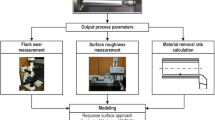Abstract
Determination of optimal cutting parameters is one of the most important elements in any process planning of metal parts. This paper presents a development of an improved genetic algorithm (IGA) and its application to optimize the cutting parameters for predicting the surface roughness is proposed. Optimization of cutting parameters and prediction of surface roughness is concerned with a highly constrained nonlinear dynamic optimization problem that can only be fully solved by complete enumeration. The IGA incorporating a stochastic crossover technique and an artificial initial population scheme is developed to provide a faster search mechanism. The main advantage of the IGA approach is that the “curse of dimensionality” and a local optimal trap inherent in mathematical programming methods can be simultaneously overcome. The IGA equipped with an improved evolutionary direction operator and a migration operation can efficiently search and actively explore solutions. The IGA approach is applied to predict the influence of tool geometry (nose radius) and cutting parameters (feed, speed, and depth of cut) on surface roughness in dry turning of SS 420 materials conditions based on Taguchi's orthogonal array method. Additionally, the proposed algorithm was compared with the conventional genetic algorithm (CGA), and we found that the proposed IGA is more effective than previous approaches and applies the realistic machining problem more efficiently than does the conventional genetic algorithm (CGA).
Similar content being viewed by others
References
Kumar R, Kumar V (2000) Optimum selection of machining conditions in abrasive flow machining using neural networks. J Mater Process Technol 108:62–67
Sonmez AI, Baykasoglu A, Dereli T, Filiz IH (1999) Dynamic optimization of multipass milling operation via geometric programming. Int J Mach Tools Manuf 39:297–320
Dereli D, Filiz IH, Bayakosoglu A (2001) Optimizing cutting parameters in process planning of prismatic parts by using genetic algorithms. Int J Prod Res 39(15):3303–3328
Goldberg DE (1989) Genetic algorithms in search, optimization and machine learning. Addison-Wesley, Reading
Walters DC, Sheble GB (1993) Genetic algorithm solution of economic dispatch with valve point loading. IEEE Trans PWRS 8(3):1325–1332
Chen PH, Chang HC (1995) Large-scale economic dispatch by genetic algorithm. IEEE Trans PWRS 10(4):1919–1926
Dasgupta D, McGregor DR (1994) Thermal unit commitment using genetic algorithms. IEE Proc-Gener Transm Distrib 141(5):459–465
Sheble GB, Maifeld TT, Brittig K, Fahd G (1996) Unit commitment by genetic algorithm with penalty methods and a comparison of Lagrangian search and genetic algorithm-economic dispatch algorithm. Int J Electric Power Energy Syst 18(6):339–346
Iba K (1994) Reactive power optimization by genetic algorithm. IEEE Trans PWRS 9(2):685–692
Lee KY, Bai X, Park YM (1995) Optimization method for reactive power planning using a genetic algorithm. IEEE Trans PWRS 10(4):1843–1850
Lee KY, Yang FF (1998) Optimal reactive power planning using evolutionary algorithms: A comparative study for evolutionary programming, evolutionary strategy, genetic algorithm, and linear programming. IEEE Trans PWRS 13(1):101–108
Dimeo R, Lee KY (1995) Boiler–Turbine control system design using a genetic algorithm. IEEE Trans Energy Convers 10(4):752–759
Zhao Y, Edwards RM, Lee KY (1997) Hybrid feed forward and feedback controller design for nuclear steam generators over wide range operation using genetic algorithm. IEEE Trans Energy Convers 12(1):100–106
Yamamoto K, Inoue O (1995) New evolutionary direction operator for genetic algorithms. AIAA J Tech Notes 33(10):1990–1993
Chiou JP, Wang FS (1998) A hybrid method of differential evolution with application to optimal control problems of a bioprocess system. In: Conf. Rec. IEEE Int. Conf. Evolutionary Computation, pp 627–632.
Soodamani R, Liu ZQ (2000) GA - based learning for a model - based object recognition system. Int J Approx Reason 23:85–109
El-Mounayri H, Dugla Z, Deng H (2003) Prediction of surface roughness in end milling using swarm intelligence. In: Proc 2003 IEEE Swarm Intelligence Symposium, pp 220–227
Tandon V, El-Mounayri H, Kishawy H (2002) NC end milling optimization using evolutionary computation. Int J Mach Tools Manuf 42:595–605
Karpat Y, Özel T (2005) Hard turning optimization using neural network modeling and swarm intelligence. Trans North Am Manuf Res Inst 33:179–186
Azouzi R, Guillot M (1997) On-line prediction of surface finish and dimensional deviation in turning using neural network based sensor fusion. Int J Mach Tools Manuf 37(9):1201–1217
Benardos PG, Vosniakos GC (2003) Predicting surface roughness in machining: a review. Int J Mach Tools Manuf 43:833–844
Jiao Y, Lei S, Pei ZJ, Lee ES (2004) Fuzzy Adaptive Networks in process modeling: surface roughness prediction for turning operations. Int J Mach Tools Manuf 44:1643–1651
Sander M (1991) A practical guide to assessment of surface texture. Gottingen, Germany
Palanikumar K (2008) Application of Taguchi and response surface methodologies for surface roughness in machining glass fiber reinforced plastics by PCD tooling. Int J Adv Manuf Technol 36:19–27
Paulo Davim J, Gaitonde VN, Karnik SR (2008) An investigative study of delamination in drilling of medium density fibreboard (MDF) using response surface models. Int J Adv Manuf Technol 37:49–57
Author information
Authors and Affiliations
Corresponding author
Rights and permissions
About this article
Cite this article
Ansalam Raj, T.G., Narayanan Namboothiri, V.N. An Improved genetic algorithm for the prediction of surface finish in dry turning of SS 420 materials. Int J Adv Manuf Technol 47, 313–324 (2010). https://doi.org/10.1007/s00170-009-2197-2
Received:
Accepted:
Published:
Issue Date:
DOI: https://doi.org/10.1007/s00170-009-2197-2




